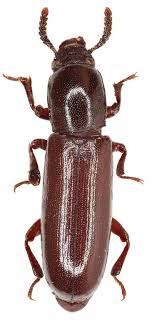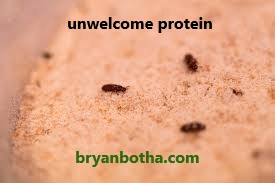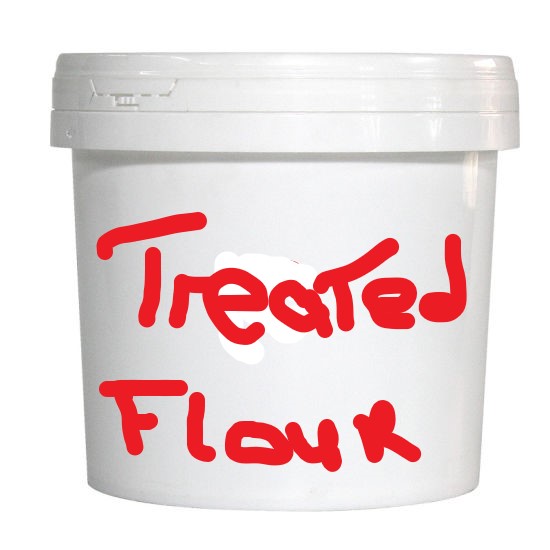Before we start with How To Save Your Flour From Pesky Flour Weevils, let’s look at what they are. The flour weevil belongs to the family called Tenebrionidae. It is a kind of beetle that is found in places that have an abundant amount of flour.
It starts at the mill, so you have little hope of preventing an infestation. Once you have a bag with a female beetle in it, it’s game over. She lays eggs in the food and packaging, and they’re so small that you are probably not going to detect them.
Two Types:

- Red flour beetle – Asian region, and the Southern Americas.
- the Confused flour beetle – the African continent
Weevil Reproduction
The eggs are collected in the crevices and the food itself. The larvae come out of these eggs and target the products that they want to eat. At this larvae stage, the beetles are usually light brown in colour, and they have six legs like all insects. After a month they transform into adult weevils. They can survive up to the age of one year. In warm conditions, the age of some species can be three years. The Confused flour weevil develops slower than the red flour weevil.
Weevils In My Flour – Where Did The Come From?
Although these pantry pests can fly, they usually like to stay near their food source so it is unlikely that they flew in. It is more than likely that they arrived with your flour from the mill or grocery store. They could have arrived as adults, larvae or eggs.
So if you’ve noticed small reddish-brown beetles, weevils, in your flour, they are probably also in your other foods in your pantry. I would also check for weevils near the pet’s food dishes as this may also be their source of food. Check for weevils in:[1]
- Cereals and grains (oats, rice, quinoa, bran).
- Crackers.
- Spices and herbs.
- Dried pasta.
- Dried fruit.
- Chocolate, candy, and nuts.
- Dried peas or beans.
If you find fuzzy webs in your cereals, rice, beans and grains, it is an indication that a tiny larva is at work. Treat the item/s as mentioned below.
Don’t Discard Any Food That Has Weevils.

It is unlikely that you will be able to see the eggs in items in your pantry but, you will be able to see the adult Weevils. Check your flour and other products for weevils and if you find any, DON’T throw away the food.
I wouldn’t eat any food that could contain live weevils if I can remove them. If you’ve accidentally baked with flour containing weevils, no problem. You can eat the food because the weevils are relatively harmless.
That is, they remove protein from the food and they leave waste and carry disease. This is relatively harmless in small quantities. It could be a problem if it is a dense infestation and a lot are consumed. The odd few are not usually a problem. I am sure our ancestors did not throw away evil infested food but rather tried to remove the weevils before preparing the food.
How To Save Your Flour From Pesky Flour Weevils
If you have visited other pages on this site, you will have realised that I am a Prepper. Something that has done me well in these trying COVID-19 times of State Of Disaster Shutdown. As a Prepper, I have stores of food that include flour, rice, peas, beans and more and to make sure they last, I have researched and tried many different methods of storage.
The secret is to do it safely and at a price that you can afford! There is all manner of methods to do this and many sites suggest methods that cost money and provide links to the suppliers (but not many advertise that they make money when you click the link).
Here are some suggestions for preserving Flour in particular. They are applicable to most of the foods at risk of weevils:

- Freeze – you can freeze your flour for four days before storing it. I Vacuum pack mine first then freeze it for a week. This ensures that, if there were weevils or eggs present, they are dead and no more can gain access to the flour.
- Heat – Heat the flour before eating it. I would use an oven. Flour can explode if given sufficient oxygen. I have not heard of it yet but there is a fan in the microwave and I don’t want to be the first to have the m/oven explode.
- Candle -If you are not going to be vacuum packing your flour, simply place a quarter of a candle in the container with your flour. This tends to keep the might out. I would still freeze it for 7 days.
- Tight-Lidded Containers – My concern with this is that the eggs/weevil may already be in the flour so you will just be sealing them in. I would definitely freeze the flour either before placing it in the container or after.
FIFO First In First Out
Remember – Flour can go bad, especially brown/whole wheat flour. Once the flour is bought, don’t keep it for too long. Always place the new food at the back and use the older food first. Don’t forget to rotate the foods already packed for transport or stored in other locations.
Clean Pantry
Vacuum and wash your pantry regularly. You need to remove the food from your pantry shelves vacuum up any loose bits of food or flour and then wash all of the shelves and anywhere that there may be spilt food with soapy water. If you’ve found weevils in other rooms of your house, make sure to vacuum them up too.[2]
Remember:-
- Immediately empty the vacuum canister in your dumpster outside so the weevils don’t stay in your kitchen trashcan.
- You don’t need to use commercial insecticides for weevils or pantry moths if you clean your pantry regularly and remove their food source.
- Wipe your pantry shelves with white vinegar or eucalyptus oil.
Airtight Containers – Do They Help?

I believe that this only helps if you freeze the flour first and then place it in the container. Failing to do this means that you may be simply placing the weevils or eggs into the sealed container to eat to their heart’s content. Remember, they are probably in your flour already, compliments of the Mill or Grocery Store.
How To Remove Weevils from Flour
- Sift the flour through a fine sieve. For rice and other grains, just before usage, soak in water for a few minutes. Weevils tend to float and you can scoop most of them off before cooking.
- Freeze your flour after sieving it. This applies to rice, beans grains etc.
- Spread it out in the sun and stir a couple of times to make sure they are all exposed. Weevils don’t like sunlight and will leave on their own. FREEZE!
- If you happen to cook something with weevils in it, tell your family it’s “spices” 🤣
OTHER IDEAS FOR PREVENTING FLOUR BUGS
I haven’t tested any of these ideas myself, but if bay leaves and/or tea tree oil haven’t worked for you, other readers also suggest:
- Food grade Diatomaceous Earth
- Lock & Lock Food Storage Bins
- Applying tea tree oil to a few cotton balls and place them throughout the pantry
- Dried Chilis
Check your pantry for weevils on a regular basis.
Conclusion
No matter what we do or where we buy our flour and other grains etc., chances are very good that we will get something with weevils in it. This does not mean that we have to discard the products but that we need to remove them and then store the items correctly.
Digesting a few weevils will not cause harm and will simply add to your protein quota for the day 😚. By taking the simple suggested steps to prevent weevils, you can protect your food from weevils and not have to explain the “spice” in the food. By doing this, you will also help the prevention of mould development.
If you have any questions, please feel free to ask them here.

We appreciate other peoples advice and opinions so before you leave, please leave your suggestion or opinion in the comments section below.


“It is better to have prepared and never to need it than to be unprepared and be in desperate need of it”.
Be Aware. Be Safe. Be Prepared!


